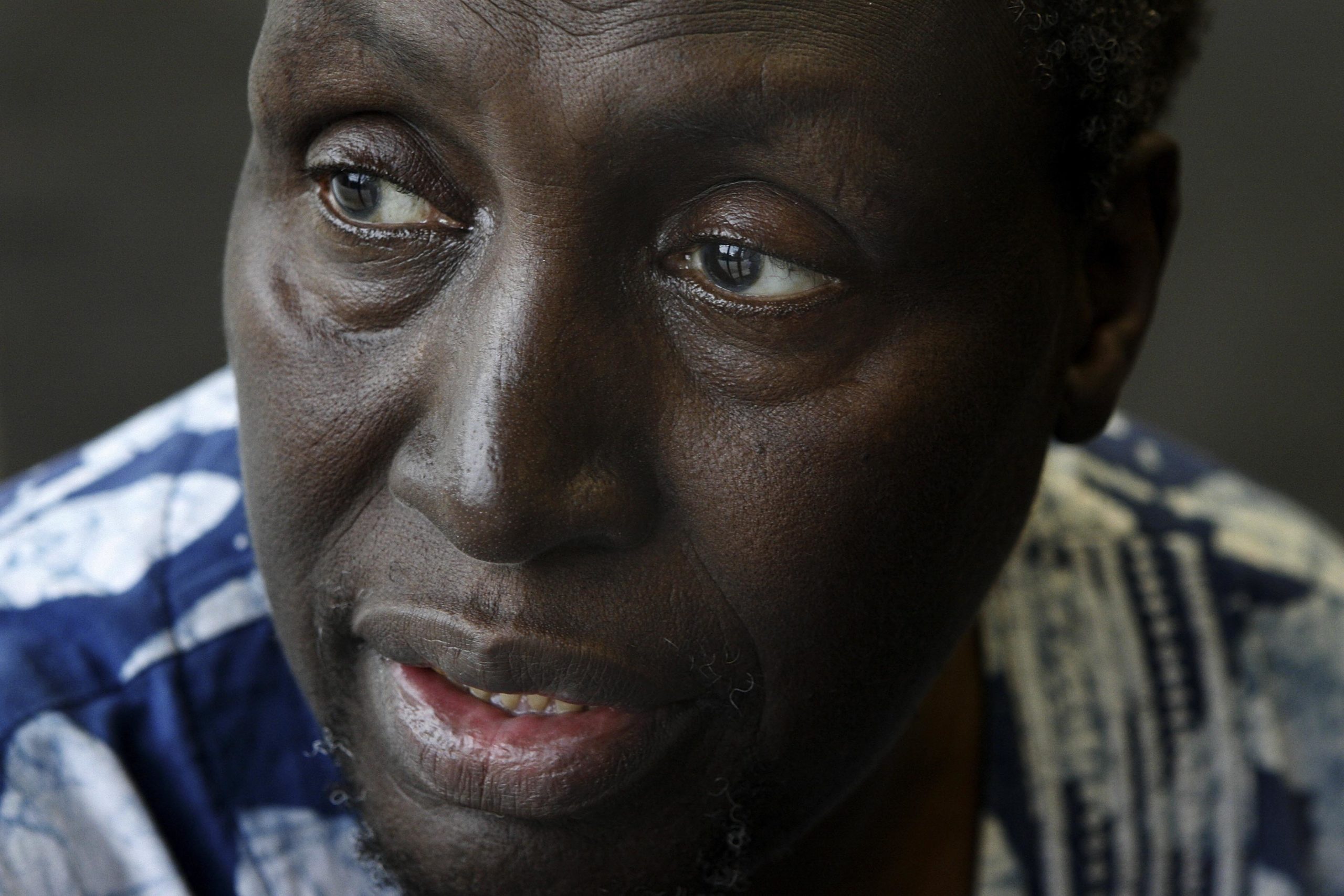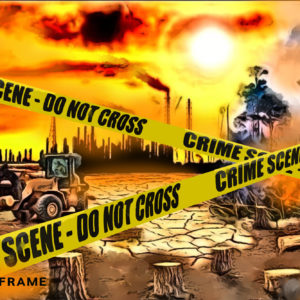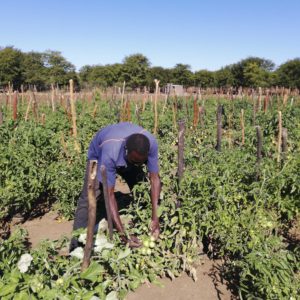Part two | Haggling hinders conservation of Manguo
There’s plenty of finger pointing as a Kenyan wetland withers. In this, the second of a two-part series, the focus is on land owners, polluters and those working to save it.
Author:
7 October 2021

Literary lion Ngũgĩ wa Thiong’o, 83, remembers Manguo from his childhood as a “magical place [of] trees, bushes and birds”. Some of that magic remains, but it might not be for long.
Increasingly, the swamp in Kenya’s central highlands is falling under a bad spell.
In the dry season its waters recede and, in the rainy season, it floods and flows downstream into people’s homes. It does not end there. Floodwaters also threaten the nearby Nairobi-Nakuru highway.
The causes of Manguo’s troubles are many. But the most significant is housing and agriculture in its floodplain. Many observers say it will be hard to remedy this problem because much of the wetland is now privately owned.
Waithaka Kang’ethe, secretary of the Manguo Land Owners’ Association, said members were ready to move out and allow the wetland to be protected and conserved – but only if the government will pay them.
“We are 70 of us, with valid title deeds. Our land covers 12 acres of the wetland. If the government can compensate us with money, we are more than willing to move out. If anything, we are the initial group that started this conservation thing here,” he said.

Mugo Kimani, the executive committee member for land in Kiambu County, the central Kenyan province that includes Manguo and Limuru, said his office was open to dialogue. However, he questioned the association’s claim. “I have never heard of anyone claiming part of the wetland. As far as I am concerned, nobody has ownership of the wetland, because it is a natural resource, and all natural resources belong to the public,” he said.
“However, if they can come to my office and we prove that they have legal ownership of the land, then we can discuss further what can be done. But, again, it’s worth noting that there’s corruption and anybody can generate any fake document. That’s why we need to look into the matter with the national government’s lands ministry,” said Kimani.
Not fake deeds
Kang’ethe rebuffed suggestions the landholders obtained title deeds illegally or that these were fake.
“This land was demarcated and given to our parents in 1958. Then, the greed for land wasn’t even there because there was huge land almost enough for everyone. Besides, even the Municipal Council of Limuru recognises that the wetland is under private ownership. That’s not a secret,” he said.
Kang’ethe said the then colonial government demarcated Manguo land and issued title deeds in 1959. He shared a 2009 Limuru municipal document which states that the wetland was subdivided into about “200 freehold, privately owned parcels of land”, much of it demarcated in the 1960s and “allocated to area residents”.

Karuga Ngigi, a Kiambu County lawmaker, feels the government ought to do more if it is serious about conserving the wetland.
“The issue of land is a sensitive one. Besides, this wetland is so important to the people of Limuru. The government should come up with a public-private partnership to revive, restore and protect the swamp. And the people who think they will permanently occupy the wetland’s land are lying to themselves, because it will preserve itself by floods that occur and cause displacement.
“That’s been the case for a long time. And the water in the wetland cannot be drained completely, in case they think that they can do that,” said Ngigi.
Trying to save the wetland
Wanjiru Mukoma, a veteran community organiser and founder of an organisation called Friends of Manguo, said they were determined to save the wetland from destruction but had no illusions about the work it would take. Building relationships with the different groups in Limuru that relied on the wetland was part of this.
She said that they had approached the Land Owners’ Association of Manguo and explained their goals.
“This was the hardest group to deal with because it consists of people who have lived here for as many as 80 years and thus claim to be the rightful occupants of the area surrounding the wetland,” said Mukoma.
She said that once the association realised the Friends were not concerned with the land ownership question they “gladly accepted and blessed” their plans to restore the wetland.
Related article:
Besides landowners, Mukoma is worried about the government’s plans to upgrade the Nairobi-Nakuru highway to four lanes.
“Already, this highway is interfering with the wetland, because anyone can see that it was [originally] constructed across the wetland. With the upgrade plans, it means that the road will eat more into the wetland’s space,” he said.
But Charles Njogu, the communications director of the Kenya National Highways Authority, downplayed these fears. “We are at the procurement stage. The design of the highway has not even been drawn. For now. I can’t comment on the environmental implications of the road’s expansion. We’ll talk about that when the design is ready,” he said.
Pollution problem
The Friends also want to stop pollution of the swamp and believe that, once restored, it will ease some of the problems caused by climate change. Getting rid of pollution will also make the building of a cultural centre on the swamp possible, said Mukoma.
And, to this end, the Friends have even enlisted the help of renowned author Ngũgĩ wa Thiong’o. He grew up around the swamp, and still has a home nearby.
The famous writer lives in the United States now, but he still cares deeply about his beloved Kenya, about Limuru and about the Manguo swamp in particular. It is an environment of his youth.
“I know the family of the professor has been having that idea [of a cultural centre connected to the swamp]. We can team up and offer something to the community, for the present and posterity. His house is just there, about 200 metres from the wetland,” said Mukoma.
Related article:
Manguo is even the subject of a magical-realism novel by the writer’s daughter, Wanjikkũ wa Ngũgĩ, titled Seasons in Hippoland. It is due for publication this October.
Contacted for comment by email, the writer said: “As children we used to swim in the Manguo waters. Beautiful.” He welcomed the efforts of the Friends of Manguo.
He blames Bata, a footwear company, for the destruction and poisoning of the swamp.
“For many years, the dirty acids from its tannery were poured into Manguo. This was pure poison. By the time the company stopped doing so… it was too late,” he said, and even suggested that the company be pursued and sued for the destruction of the wetland.
However, Bata said Ngũgĩ’s claims were not valid.
Related podcast:
John Ngoru, human resource head for the company’s Africa region, said it was impractical for it to drain waste into Manguo: “The wetland is on a higher ground in relation to our plant. How, then, can waste flow uphill?”
He said their plant had been on the same 65-hectare site – about 1km south of Manguo – since the company began operations in Limuru in 1946.
Ngoru acknowledged their tannery had, for many years, “produced a powerful, awful smell” that had plagued Limuru. But he said the stench had ceased about 20 years ago when Bata switched from using raw to semi-processed skins.
“Our tanning process is now cleaner and environmentally friendly. We also have our sewer system, where we drain into, after internally treating the waste,” he said. He added that their operations undergo environmental audits every year.
Related article:
Ngoru said it is not his company that is to blame but human encroachment and settlement, and the government needed to deal with the “issue of the wetland’s ownership”.
Bata would, however, consider appeals for assistance from the Friends of Manguo, Ngoru said.
However, according to some local residents, Bata has not been the only culprit. An abattoir near the wetland has been polluting the swamp and killing its resident and visiting animals, they said.

The Bahati Slaughterhouse’s manager Alex Mburu Kang’ethe (no relation to the landowners association secretary) rejected this claim.
“We slaughter an average of 60 cows a day and we manage our waste well. We have three septic tanks where we treat the waste before releasing it to the sewer line. In addition, we have been certified by all the necessary government authorities, including the veterinary department and the National Environment Management Authority to run this slaughterhouse,” he said.
The authority confirmed that the abattoir, which has been operating for more than two decades, was certified and compliant. “Otherwise it could have been closed down a long time ago,” it said in a statement.
Land ownership and water problems
Wanjiru believed that if water from the wetland was well managed and protected, it could help reduce hunger in the area.
“We are experiencing floods and droughts here, unlike before. During some months of the year, the wetland also almost dries up. At such times, we experience food shortages. That is why we want to restore the waters, so that the local people can use it for irrigation, and also create jobs for the many unemployed youth,” she said.
The group held meetings and training sessions on water conservation with the Water Resources Authority.
John Kinyanjui, a manager for monitoring and assessment with the authority, said protecting the wetland has proved difficult over the years because of the many people who claim ownership to parts of it.
Related article:
However, a new plan was being drafted to get things done.
“We are now planning to regulate what can be done by the people who have title deeds to the riparian [land] because it’s hard to have full control over the area. We will have a dialogue with them and lay out what they cannot do. Such things include banning cultivating the area, clearing indigenous trees, putting up permanent structures, dumping any waste and planting any exotic trees.
“If they oppose those plans, then we will have to bring on board the National Land Commission to solve the puzzle of land ownership of the wetland,” he said.
“We have several wetlands and swamps in Kiambu and Nairobi whose land has been subdivided by the local residents. Interestingly, the people end up being chased away by the very wetlands whenever it rains. People should know that there’s more than cultivation and construction in these areas. Wetlands do us more good when they are left untouched. Perhaps what they should do is enhance their potential by encouraging wildlife and tourism,” he said.
Boreholes and blockages
Caroline Muriuki, the National Environment Management Authority’s senior officer in charge of wetlands, regrets that the authority has limited control of Manguo. What made matters worse, she said, was the country’s water resource authority’s boreholes.
“Manguo is bedeviled with multiple ownership by private people, and those people have title deeds. Thus, it becomes very hard for us to involve ourselves. Besides, the Limuru Water and Sewerage Company overdraws water from the wetland. That’s why it’s facing the risk of drying up,” she said.
A senior officer from the water company, however, disputed this. “Our company has a total of six boreholes, four of which are located near the wetland. The four boreholes produce 15-cubic metres of water per hour. Again, the boreholes don’t pump out water directly from the wetland. Instead, they pump from 200 metres deep. With that, you can’t say that we over-extract water,” the source said.
The Water Resources Authority’s Kinyanjui agreed. He said the boreholes dug near the wetland drew water from deep underground, not directly from the wetland. “Besides, we do monitoring and regulation of the maximum amount of water that the boreholes should pump out. There is nothing like overdrawing water,” he said.

But John Mironga, a researcher on wetland ecology and a senior lecturer at Egerton University, is not convinced.
“The company knows why they drilled boreholes near the wetland. It is because they know that the water table is near the surface in wetlands, thus water is always guaranteed. In addition, the excess water in wetlands sinks down to the ground. So that is the very water that the company is pumping out,” he said.
“If you pass along the highway, you will clearly see that the wetland is almost becoming like a field. In fact people play there, because it is dry. But that’s not how it used to be. As much as they deny it, their boreholes have contributed to the shrinking of the wetland’s surface water,” he said.
Mironga also warned that blocking swamps – as has been done by homeowners downstream – harmed natural systems and affected water quality.
“Wetlands are fresh water bodies. When you block exits, you keep water within them unnecessarily long. The longer water overstays without naturally flowing, the more its alkalinity rises. The water stops being fresh and that affects the organisms which are living in that ecology,” he said.

Mbira Mukoma, secretary of Friends of Manguo, said that unless solved, the conflict between the boreholes and the wetland would remain.
“The wetland has always been there. The boreholes just came and were drilled in the wrong place. As long as they are there, the wetland’s water levels will always remain checked, so as not to submerge the pump stations. That’s wrong. I hope that the company can find a way of moving away the pump stations from the wetland, to a higher place, so that the waters can be full as they ought to be, naturally,” he said.
“If the public could know the importance of wetlands in our ecosystem and water cycle, they could be more zealous in protecting them. Highland wetlands are usually located in highly productive areas, with high rainfall. Thus, they absorb and keep most of the rainwater when it rains. This water can always be used in the future when there is drought. In addition, they control floods, especially in the lowlands, by keeping most of the runoff water,” said Muriuki.
Related article:
She said Kenya already had extensive laws for the conservation of wetlands and did not need more.
“In fact, Uganda and Rwanda have borrowed and implemented them, and are now doing better than us. So what we need more than anything else is sensitisation of the public to do what should be done,” she said.
Mironga said that wetlands were vital to ecosystems and should be jealously protected.
“Wetlands are like kidneys. They filter the waste that comes into them in all forms: solid, liquid and gas. Wetlands make up 6% of the earth. Moreover, they absorb 20% of [the] earth’s carbon content, thus controlling global warming and climate change. Kenya’s inland wetlands occupy about 2 641 690 hectares,” he said.
Related article:
He said Manguo was in greater danger than many other wetlands, owing to its location.
“It is along the crucial Nairobi-Nakuru highway and just next to Limuru town, and so it’s very accessible. Anyone passing there sees it as a land full of potential for growth and development. With the increasing population pressure from Nairobi and Limuru town, Manguo wetland is in danger of dying away,” he said.
The community and Limuru Water and Sewerage Company should combine forces to protect the wetland, added Mironga.
“The water company makes a lot of money from the water that it gets from the wetland. Ideally, it should plough back some of its profits and use it to conserve the wetland.”
Steve Mokaya is in the final year of his bachelor degree course in journalism and mass communication, in Mombasa, Kenya. His story was written with the guidance of environmental news agency Roving Reporters and forms part of a biodiversity-reporting project supported by the Internews Earth Journalism Network.







